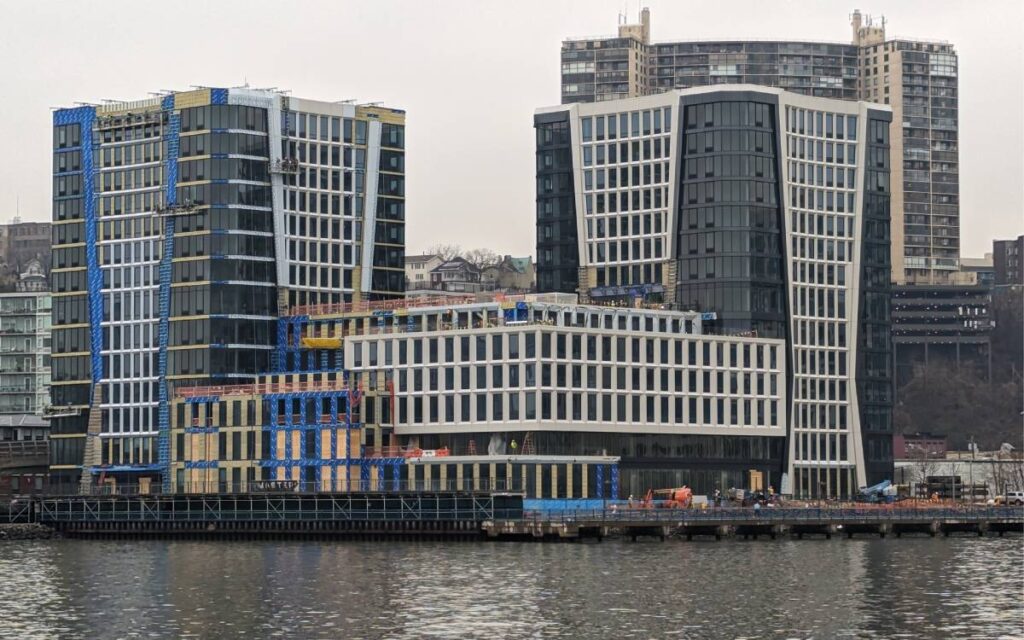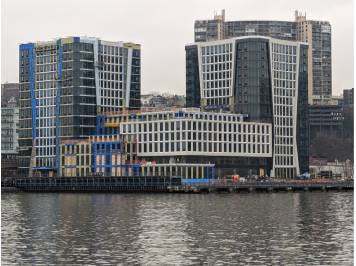Hartz Mountain built these luxury residential towers despite pending litigation

Hoboken Point at the Weehawken Cove nearing completion in the spring of 2024.
FBW | January 24, 2025
Hoboken Point is situated overlooking the Weehawken Cove, a unique inlet of the Hudson River. According to promotional material, this 262-unit residential development is designed to evoke the feeling of being aboard a luxury yacht. The two 14-story towers contain over 17,000 square feet of amenities including the Work Lab, a co-working space.
On December 9, 2024, a few months after Hoboken Point’s grand opening, a New Jersey Appellate Court issued a decision rescinding the required state waterfront permit.
In May 2020, Eagle Rock Properties challenged the New Jersey Department of Environmental Protection (NJDEP) permit application, several years before Hartz Mountain began construction in spite of this and other litigation challenging approvals granted for the project.
Hoboken Point is located at 100 Harbor Boulevard in the Township of Weehawken directly north of the Hoboken border. It is the latest project in Hartz Mountain’s 60-acre Lincoln Harbor development, begun in the 1980s, that includes a mix of commercial and residential projects plus a Whole Foods Market, a Sheraton Hotel and several restaurants. On the Hoboken side of the Cove, one of the final segments of Hoboken’s waterfront park is currently under construction.
Eagle Rock’s appeal of the NJDEP permit approval contended that the project failed to comply with New Jersey’s Coastal Zone Management Regulations pertaining to high-rise structures, traffic and the filled water’s edge. In its legal brief, Eagle Rock also argued that the project encroached on the conservation easement of the Hudson River Waterfront Walkway. In response to the issues raised in this appeal, the NJDEP filed a motion for a remand to further develop the record and reconsider the application. The court granted the NJDEP’s motion.
In 2020, inresponse to Hartz’s permit application, hundreds of area residents submitted to the NJDEP their objections and requested a public hearing. Many stated that views they enjoyed from their homes to the Hudson River would be significantly obstructed. The NJDEP declined to conduct a public hearing.
Because Hartz never recorded a conservation easement from its 2010 NJDEP permit, the NJDEP added a pre-construction condition requiring Hartz to “file a conservation restriction for the authorized 30-foot easement and Hudson River Waterfront Walkway with related walkway amenities.”
After the remand, Rock Eagle claimed that the NJDEP erred by failing to afford it and other interested parties the opportunity to submit their own comments and data challenging the new documents. The court agreed concluding: “Simply stated, by failing to give interested parties notice that it was accepting additional submissions from Hartz on traffic and viewsheds, after which it would reconsider the permit under the Waterfront Development standards, and that those persons were also entitled to make their views known and to have them considered by the Department in rendering its decision on the permit, DEP failed to ‘turn square corners’ in its dealings with the public in its conduct of our last remand.”
The court decision continued: “It was not our intent in granting the Department’s request to remand for our order to become ‘an instrument of mischief’; we shall not allow it to continue . . . Our disposition makes discussion of Rock Eagle’s remaining issues unnecessary. The decision on remand is reversed and the individual waterfront permit, as modified, is vacated in its entirety.”
The challenge to the waterfront permit also raised issues pertaining to flood risk as the site is located within the Hudson River floodplain. The federal Rebuild by Design floodwall will be built on the upland side of Hoboken Point. The building is situated directly at the edge of the Hudson River with the required walkway to the east on piles over the river. To the south, in Hoboken, the floodwall will be hidden within the landscaped public park that is currently under construction.
In August 2020, Rock Eagle Properties and the Fund for a Better Waterfront (FBW) had also challenged approvals for Hoboken Point granted by the Weehawken Planning Board. The plaintiffs claimed the project failed to comply with ordinance standards for setbacks, lot coverage, distance between buildings, FAR (floor area ratio) and open space. For example, the development must provide a minimum of 20 percent open space but in fact only allows for 9.8 percent. In addition, there is a 50 foot minimum front and rear yard setback requirement but the project proposes a mere 4.5 and 4 feet respectively. The failure to meet the FAR standard requires what is known as a “D” variance. Only the Zoning Board of Adjustment can grant such a variance, not the Planning Board. FBW’s case is pending before Judge Anthony V. D’Elia of the Superior Court of New Jersey in Hudson County.
Related links
Appellate Court Decision revoking waterfront permit
Court challenge moves forward as Hartz drives piles for high-rise towers
FBW appeals approvals for high-rise development at Weehawken Cove
Latest Lincoln Harbor project disregards good planning principles
Liberty Harbor North Redevelopment Plan
Multiple lawsuits challenge new ordinance for Lincoln Harbor
Planning Board votes down high-rise towers at Weehawken Cove after persistent opposition
Objectors mobilize against massive towers proposed at Weehawken Cove
Col. Stevens vision for Hoboken still valid 200 years later
Hoboken’s first parks established in 1804


